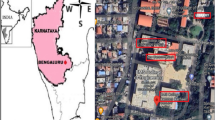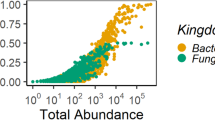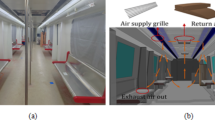Abstract
Bio-aerosol is a well-known cause of respiratory diseases. Exposure to bio-aerosols has been reported previously in dairy barns, but little is known about the sources of bio-aerosol. Bedding materials might be a significant source or substrate for bio-aerosol exposure. The aim of this study was to explore bio-aerosol exposure levels and its determinants in dairy barns with various bedding materials. Dust samples were collected at dairy barns using various bedding materials. Samples were analyzed for endotoxin and β(1 → 3)-glucan contents. Culturable bacteria and fungi were sampled by the Anderson N6 impactor. Exposure models were constructed using linear mixed models. The personal exposure levels to dust, endotoxin, and β(1 → 3)-glucan differed significantly between the barns utilizing diverse main bedding types (P<0.05), with the highest levels (GM: dust, 1.38 mg/m3; endotoxin, 895 EU/m3; β(1 → 3)-glucan, 7.84 μg/m3) in barns with compost bedding vs the lowest in barns with sawdust bedding (GM: dust, 0.51 mg/m3; endotoxin, 183 EU/m3; β(1 → 3)-glucan, 1.11 μg/m3). The exposure levels were also highly variable, depending on various extra bedding materials applied. Plant materials, particularly straw, utilized for bedding appeared to be a significant source for β(1 → 3)-glucan. Compost was significantly associated with elevated exposure levels. Between-worker variances of exposure were highly explained by determinants of exposure like type of bedding materials and milking by robot, whereas determinants could explain to lesser extent the within-worker variances. Exposure levels to endotoxin, β(1 → 3)-glucan, bacteria, and fungi in dairy barns were substantial and differed depending on bedding materials, suggesting bedding material types as a significant predictor of bio-aerosol exposure.
This is a preview of subscription content, access via your institution
Access options
Subscribe to this journal
Receive 6 print issues and online access
$259.00 per year
only $43.17 per issue
Buy this article
- Purchase on SpringerLink
- Instant access to full article PDF
Prices may be subject to local taxes which are calculated during checkout


Similar content being viewed by others
References
Radon K., Danuser B., Iversen M., Monso E., Weber C., and Hartung J., et al. Air contaminants in different european farming environments. Ann Agric Environ Med 2002: 9 (1): 41–48.
Kullman G.J., Thorne P.S., Waldron P.F., Marx J.J., Ault B., and Lewis D.M., et al. Organic dust exposures from work in dairy barns. Am Ind Hyg Assoc J 1998: 59 (6): 403–413.
Preller L., Heederik D., Kromhout H., Boleij J.S., and Tielen M.J. Determinants of dust and endotoxin exposure of pig farmers: development of a control strategy using empirical modelling. Ann Occup Hyg 1995: 39 (5): 545–557.
Samadi S., Wouters I.M., Houben R., Jamshidifard A.R., Van Eerdenburg F., and Heederik D.J. Exposure to inhalable dust, endotoxins, beta(1->3)-glucans, and airborne microorganisms in horse stables. Ann Occup Hyg 2009: 53 (6): 595–603.
Samadi S., Heederik D.J., Krop E.J., Jamshidifard A.R., Willemse T., and Wouters I.M. Allergen and endotoxin exposure in a companion animal hospital. Occup Environ Med 2010: 67 (7): 486–492.
Schierl R., Heise A., Egger U., Schneider F., Eichelser R., and Neser S., et al. Endotoxin concentration in modern animal houses in southern Bavaria. Ann Agric Environ Med 2007: 14 (1): 129–136.
Spaan S., Wouters I.M., Oosting I., Doekes G., and Heederik D. Exposure to inhalable dust and endotoxins in agricultural industries. J Environ Monit 2006: 8 (1): 63–72.
Torok V.A., Hughes R.J., Ophel-Keller K., Ali M., and Macalpine R. Influence of different litter materials on cecal microbiota colonization in broiler chickens. Poult Sci 2009: 88 (12): 2474–2481.
Virtanen T., Vilhunen P., Husman K., Happonen P., and Mantyjarvi R. Level of airborne bovine epithelial antigen in Finnish cowsheds. Int Arch Occup Environ Health 1988: 60 (5): 355–360.
Breum N.O., Nielsen B.H., Lyngbye M., and Midtgard U. Dustiness of chopped straw as affected by lignosulfonate as a dust suppressant. Ann Agric Environ Med 1999: 6 (2): 133–140.
Kaliste E., Linnainmaa M., Meklin T., Torvinen E., and Nevalainen A. The bedding of laboratory animals as a source of airborne contaminants. Lab Anim 2004: 38 (1): 25–37.
Platts-Mills T.A., Heymann P.W., Longbottom J.L., and Wilkins S.R. Airborne allergens associated with asthma: particle sizes carrying dust mite and rat allergens measured with a cascade impactor. J Allergy Clin Immunol 1986: 77 (6): 850–857.
Spaan S., Doekes G., Heederik D., Thorne P.S., and Wouters I.M. Effect of extraction and assay media on analysis of airborne endotoxin. Appl Environ Microbiol 2008: 74 (12): 3804–3811.
Douwes J., Doekes G., Montijn R., Heederik D., and Brunekreef B. Measurement of beta(1-->3)-glucans in occupational and home environments with an inhibition enzyme immunoassay. Appl Environ Microbiol 1996: 62 (9): 3176–3182.
Andersen A.A. New sampler for the collection, sizing, and enumeration of viable airborne particles. J Bacteriol 1958: 76 (5): 471–484.
Health Council of the Netherlands. Endotoxins. Health-Based Recommended Occupational Exposure Limit. Health Council of the Netherlands: The Hague, 2010. Report No.: 2010/04OSH.
Samadi S ., Rietbroek NN ., Dwars RM., Jamshidifard AR., Heederik DJ., and Wouters IM. Endotoxin and β-(1 → 3)-glucan exposure in poultry and ruminant clinics. J Environ Monit 2011: 13 (11): 3254–3261.
Halstensen A.S., Nordby K.C., Wouters I.M., and Eduard W. Determinants of microbial exposure in grain farming. Ann Occup Hyg 2007: 51 (7): 581–592.
Wouters I.M., Spaan S., Douwes J., Doekes G., and Heederik D. Overview of personal occupational exposure levels to inhalable dust, endotoxin, beta(1-->3)-glucan and fungal extracellular polysaccharides in the waste management chain. Ann Occup Hyg 2006: 50 (1): 39–53.
Milling A., Kehr R., Wulf A., and Smalla K. Survival of bacteria on wood and plastic particles: dependence on wood species and environmental conditions. Holzforschung 2005a: 59: 72–81.
Fries R., Akcan M., Bandick N., and Kobe A. Microflora of two different types of poultry litter. Br Poult Sci 2005: 46 (6): 668–672.
Hogan J.S., Bogacz V.L., Thompson L.M., Romig S., Schoenberger P.S., and Weiss W.P., et al. Bacterial counts associated with sawdust and recycled manure bedding treated with commercial conditioners. J Dairy Sci 1999: 82 (8): 1690–1695.
Hogan J.S., and Smith K.L. Bacteria counts in sawdust bedding. J Dairy Sci 1997: 80 (8): 1600–1605.
Cyprowski M., Sowiak M., and dkowska-Stañczyk I. β(1 → 3)-glucan aerosols in different occupational environments; doi:10.1007/s10453-011-9201-7.
Louhelainen K., Kangas J., Husman K., and Terho E.O. Total concentrations of dust in the air during farm work. Eur J Respir Dis Suppl 1987: 152: 73–79.
Ko G., Simmons Iii O.D., Likirdopulos C.A., Worley-Davis L., Williams C.M., and Sobsey M.D. Endotoxin levels at swine farms using different waste treatment and management technologies. Environ Sci Technol 2010: 44 (9): 3442–3448.
Adhikari A., Gupta J., Wilkins III J.R., Olds R.L., Indugula R., and Cho K.J., et al. Airborne microorganisms, endotoxin, and (1->3)-{beta}-D-glucan exposure in greenhouses and assessment of respiratory symptoms among workers. Ann Occup Hyg 2011: 55 (3): 272–285.
Douwes J. (1-->3)-beta-D-glucans and respiratory health: a review of the scientific evidence. Indoor Air 2005: 15 (3): 160–169.
Burton R.A., and Fincher G.B. (1,3;1,4)-beta-D-glucans in cell walls of the poaceae, lower plants, and fungi: a tale of two linkages. Mol Plant 2009: 2 (5): 873–882.
Thorne P.S., Ansley A.C., and Perry S.S. Concentrations of bioaerosols, odors, and hydrogen sulfide inside and downwind from two types of swine livestock operations. J Occup Environ Hyg 2009: 6 (4): 211–220.
Acknowledgements
We thank the management and workers of the dairy farms for the collection of dust samples. We also acknowledge Jack Spithoven and Siegfried de Wind for endotoxin and β(1 → 3)-glucan analysis.
Author information
Authors and Affiliations
Corresponding author
Ethics declarations
Competing interests
The authors declare no conflict of interest.
Rights and permissions
About this article
Cite this article
Samadi, S., van Eerdenburg, F., Jamshidifard, AR. et al. The influence of bedding materials on bio-aerosol exposure in dairy barns. J Expo Sci Environ Epidemiol 22, 361–368 (2012). https://doi.org/10.1038/jes.2012.25
Received:
Accepted:
Published:
Issue date:
DOI: https://doi.org/10.1038/jes.2012.25
Keywords
This article is cited by
-
Upper and lower respiratory airway complaints among female veterinary staff
International Archives of Occupational and Environmental Health (2022)
-
Impact of bacterial aerosol, particulate matter, and microclimatic parameters on animal welfare in Chorzów (Poland) zoological garden
Environmental Science and Pollution Research (2021)
-
Respiratory diseases and allergy in farmers working with livestock: a EAACI position paper
Clinical and Translational Allergy (2020)
-
A comprehensive review of levels and determinants of personal exposure to dust and endotoxin in livestock farming
Journal of Exposure Science & Environmental Epidemiology (2015)



